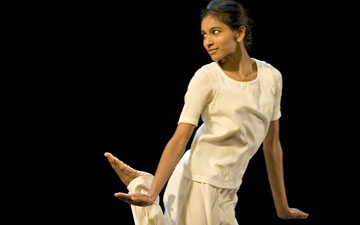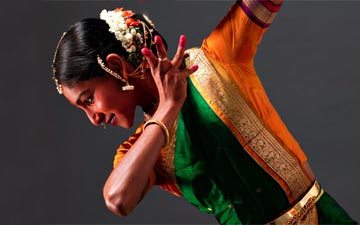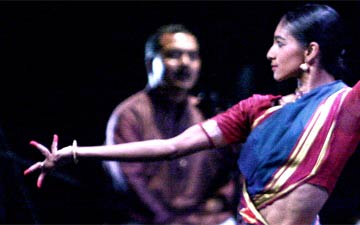
© Elian Bachini. (Click image for larger version)
Shantala Shivalingappa
Akasha
★★★★✰
New York, Joyce Theater
9 October 2019
shantalashivalingappa.com
www.joyce.org
Cosmic Dance
At the end of her solo evening Akasha, Shantala Shivalingappa steps into a bright rectangle at the rear of the stage, accompanied by a drum beating out a repeated rhythmic figure, and chanting. She is in silhouette, the outlines of her slender frame and well-defined profile clean and sharp against a bluish light. As she shifts from one sculptural shape to the next, her fingers vibrate with the beats of the drum, so precisely, so exactly, that the vibrations of sound and body merge into one. As the program explains, Akasha, which means sky and space in Sanskrit, is born of vibrations. It’s an electrifying moment, in which stage craft, music, and dancing merge into a single image and sensation, the kind that stays with you long after the show has ended.
Shivalingappa is good at endings – I remember another in which a silk curtain crumpled to the ground with the last notes of music, and yet another in which she circled the stage over and over, spinning on her knees, becoming almost a blur. The Indian classical dancer, a specialist in kuchipudi, from the southern state of Andhra Pradesh, has learned well from her experiences of working with contemporary theater and dance masters, including Peter Brook, Maurice Béjart, and Pina Bausch. Shivalingappa grew up in Paris. In addition to kuchipudi, she has been involved in the contemporary dance scene for a long time. Her dance evenings, though traditional in format – a suite of solos set to songs in different styles, accompanied by four onstage musicians – have a particular polish and an elegance that sharpens their contours. In Akasha, arrangements of flowers hang in mobile-like formation above the stage, a dancing Shiva sculpture (or Nataraja) at the pinnacle. A subtle glow illuminates them. The musicians sit on either side of the stage on platforms. A portal at the rear allows for quick entrances and exits. It’s all very simple but pleasing to the eye.
Everything in Shivalingappa’s style (of dance, of presentation) emphasizes clarity, shape, and intention. Her body, more linear and lithe than typical for classical Indian dancers, creates clear, curving or angular shapes. She wears light makeup and simple hair-decorations, and her facial expressions in abhinaya (or storytelling) are open, direct, even, at times, subtle. But more than anything it is the dancing, with its crystalline shapes, quick, sharp, airy jumps, and rhythmic purity, that shines out with extraordinary clarity. At one point she enters the stage in a diagonal of leaps, powerfully driven by the drums; you feel you are watching an animal, like a gazelle, whose natural locomotion consists of bounding through the air.

© Elian Bachini. (Click image for larger version)
Unlike Bharatanatyam or odissi, other classical Indian dance forms, kuchipudi contains a lot of jumps – small, big, and in between – as well as a particular lilt and sway in the torso. In an interview in 2014, Shivalingappa explained the style: “There is something very strong in the legs – it’s very intricate and quick in the footwork and also very anchored into the earth – but the upper body is full of grace and swaying and undulating.” Her dancing illustrates this perfectly. Her teacher, the innovator Vempati Chinna Satyam, is known for the refined movement style he passed on to his pupils. Shivalingappa also makes ample use of the stage space, criss-crossing it in diagonals, circles, and asymmetrical lines. The choreography, mostly her own, is imaginative – you don’t feel like you’ve seen this or that idea before. (Two of the five sections were choreographed by Vempati Ravi Shankar, her teacher’s late son.)
Though she distinguishes herself particularly in the abstract, rhythmic, and melodic passages (or nrita), she can be equally compelling in her storytelling. In Krishnam Kalaya, she became the god Krishna as a young boy, gleefully playing in the dirt. She fell to the ground, kicking her legs, throwing dirt into the air, even eating it. She seemed transformed, child-like, filled by an almost animalistic pleasure. With a swift change of position, she became a young woman, at first horrified, then surprised, and finally delighted by the boy’s mischief. Each subtle change in her attitude was crystal-clear; we saw the child not only though our eyes, but through hers. In Kirtanam, about a love quarrel between the Goddess Alamelu Manga and her husband, Venkateshwara, I was struck by the image of the husband pulling on the wife’s skirt, and the wife pushing his hand away. Shivalingappa played both characters; it was perfectly clear who was whom, what each character was feeling, how the dynamic of the quarrel was shifting, who had the upper hand. The husband wiped the wife’s tears away; the wife felt his fingers on her cheek, and so did we.
Clarity, purity, and emotion – Akasha contains all three. As well as wonderfully melodic, rhythmically-driven music by Shivalingappa’s four musicians. The flutist, Jayaram Kikkeri Suryanarayana, has a particularly sweet sound. A rhythmic battle between the two drummers, Ramakrishnan Neelamani and Haribabu Balan Puttamma, was a high point, blending virtuosity and wit. The steps and the music were truly one.
All of which made for a very satisfying evening of dance.

















Marina Harss’s review of Shantala fills me with envy. I have seen her twice under the auspices of S.F. Performances, but she is not on this year’s roster of artists, alas.
As usual, Marina’s comments are vivid and gratifying. Here’s hoping Shantala
will make the presenter’s roster with her next U.S. tour.